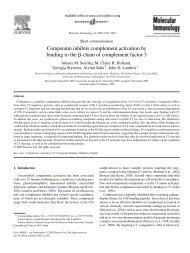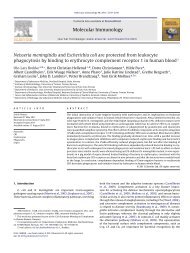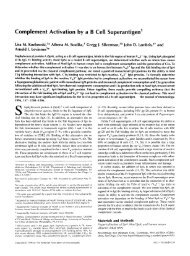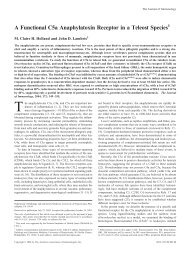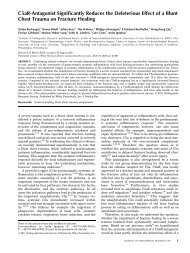Hydrophobic Effect and Hydrogen Bonds Account for the Improved ...
Hydrophobic Effect and Hydrogen Bonds Account for the Improved ...
Hydrophobic Effect and Hydrogen Bonds Account for the Improved ...
You also want an ePaper? Increase the reach of your titles
YUMPU automatically turns print PDFs into web optimized ePapers that Google loves.
4616 J. Med. Chem. 2006, 49, 4616-4622<br />
<strong>Hydrophobic</strong> <strong>Effect</strong> <strong>and</strong> <strong>Hydrogen</strong> <strong>Bonds</strong> <strong>Account</strong> <strong>for</strong> <strong>the</strong> <strong>Improved</strong> Activity of a Complement<br />
Inhibitor, Compstatin<br />
Madan Katragadda, Paola Magotti, Georgia Sfyroera, <strong>and</strong> John D. Lambris*<br />
Protein Chemistry Laboratory, Department of Pathology & Laboratory Medicine, School of Medicine, UniVersity of PennsylVania,<br />
Philadelphia, PennsylVania 19104<br />
ReceiVed March 23, 2006<br />
Tryptophans at positions 4 <strong>and</strong> 7 of compstatin, a peptide complement inhibitor, are crucial <strong>for</strong> its interaction<br />
with C3. However, <strong>the</strong> nature of <strong>the</strong>ir involvement has not been studied to date. Here we investigate <strong>the</strong><br />
molecular <strong>for</strong>ces involved in <strong>the</strong> C3-compstatin interactions, mediated by aromatic residues, by incorporating<br />
in <strong>the</strong>se two positions various tryptophan analogues (5-methyltryptophan, 5-fluorotryptophan, 1-methyltryptophan,<br />
<strong>and</strong> 2-naphthylalanine) <strong>and</strong> assessing <strong>the</strong> resulting peptides <strong>for</strong> activity by enzyme-linked<br />
immunosorbent assay (ELISA) <strong>and</strong> binding by iso<strong>the</strong>rmal titration calorimetry (ITC). Of all <strong>the</strong> compstatin<br />
analogues, peptides containing 1-methyltryptophan at position 4 exhibited <strong>the</strong> highest binding affinity<br />
(K d ) 15 nM) <strong>and</strong> activity (IC 50 ) 0.205 µM), followed by a peptide containing 5-fluorotryptophan at<br />
position 7. Our observations suggest that hydrophobic interactions involving residues at position 4 <strong>and</strong> <strong>the</strong><br />
hydrogen bond initiated by <strong>the</strong> indole nitrogen are primarily responsible <strong>and</strong> crucial <strong>for</strong> <strong>the</strong> increase in<br />
activity. These findings have important implications <strong>for</strong> <strong>the</strong> design of clinically useful complement inhibitors.<br />
* Corresponding author: phone 215-746-5765; fax 215-573-8738; e-mail<br />
lambris@mail.med.upenn.edu.<br />
Introduction<br />
Compstatin is a 13-amino acid cyclic peptide inhibitor that<br />
binds to <strong>the</strong> β-chain of C3, 1 a complement component that is<br />
central to all three pathways of <strong>the</strong> complement system<br />
(classical, alternative, <strong>and</strong> lectin). 2 A number of inhibitors<br />
ranging from small organic compounds to large-size proteins<br />
have been designed to act at several points in <strong>the</strong> complement<br />
cascade, but compstatin, a 13-amino acid cyclic peptide (ICV-<br />
VQDWGHHRCT-NH 2 ), is unique in acting at <strong>the</strong> level of C3. 3<br />
Compstatin has been tested successfully in several in vivo <strong>and</strong><br />
ex vivo animal models <strong>and</strong> has shown enormous potential <strong>for</strong><br />
development as a complement <strong>the</strong>rapeutic. 4-7 The threedimensional<br />
structure of <strong>the</strong> peptide, as determined by NMR,<br />
shows a coil with a type II β-turn involving Q5-D6-W7-G8. 8<br />
With this structure as a template, several combinatorial,<br />
computational, <strong>and</strong> rational design approaches have been carried<br />
out to enhance <strong>the</strong> activity of compstatin. 10,11 These enhancements<br />
have yielded a peptide, having 2-naphthylalanine in<br />
position 4, with 99-fold higher activity than that of <strong>the</strong> parent<br />
molecule. Several of <strong>the</strong> most active analogues have contained<br />
tryptophan or o<strong>the</strong>r aromatic ring structures at positions 4 or-<br />
(<strong>and</strong>) 7, underscoring <strong>the</strong> importance of an aromatic ring<br />
structure at <strong>the</strong>se positions <strong>for</strong> complement inhibitor activity. 12<br />
Despite this increase in activity, very little is known about<br />
<strong>the</strong> underlying molecular <strong>for</strong>ces that impart recognition <strong>and</strong><br />
specificity to compstatin <strong>and</strong> <strong>the</strong>reby dictate its inhibitory<br />
activity. Incorporation of aromatic residues such as tyrosine at<br />
position 4 results in a lower activity than that seen when<br />
tryptophan is present. 10,11 The fact that tryptophan <strong>and</strong> tyrosine<br />
differ in <strong>the</strong> electrostatic potentials of <strong>the</strong>ir ring suggested a<br />
possible correlation between <strong>the</strong> ring current <strong>and</strong> <strong>the</strong> inhibitory<br />
activity; indeed, an increase in inhibitory activity was observed<br />
with an increase in <strong>the</strong> negative electrostatic potential. Such a<br />
relationship is indicative of a cation-π interaction, as has been<br />
described <strong>for</strong> several protein-protein interactions. 13-18 In addition,<br />
<strong>the</strong> higher hydrophobicity of tryptophan when compared<br />
to tyrosine may also be responsible <strong>for</strong> <strong>the</strong> higher activity<br />
observed.<br />
Compstatin contains a tryptophan residue at position 7 that<br />
participates in <strong>the</strong> <strong>for</strong>mation of <strong>the</strong> β turn. 8 Substitution of this<br />
tryptophan residue with alanine or phenylalanine results in loss<br />
of activity, 9 thus indicating that tryptophan is crucial at this<br />
position <strong>for</strong> <strong>the</strong> structural stability <strong>and</strong>/or activity of compstatin.<br />
Loss of activity upon substitution by phenylalanine indicates<br />
that Trp7, in addition to Trp4, may mediate a cation-π<br />
interaction or <strong>the</strong> <strong>for</strong>mation of a hydrogen bond between <strong>the</strong><br />
N-H <strong>and</strong> a hydrogen-bond acceptor on C3. However, <strong>the</strong> role<br />
of Trp7 in <strong>the</strong>se interactions has not been delineated at <strong>the</strong><br />
atomic level.<br />
In this study we have used peptide syn<strong>the</strong>sis <strong>and</strong> iso<strong>the</strong>rmal<br />
titration calorimetry (ITC) a analysis to examine <strong>the</strong> potential<br />
noncovalent interactions involved in this interaction between<br />
C3 <strong>and</strong> compstatin <strong>and</strong> to analyze <strong>the</strong> role of selective hydrogen<br />
bonding at positions 4 <strong>and</strong> 7. Analyses in which we introduced<br />
<strong>the</strong> tryptophan analogues 5-fluorotryptophan, 5-methyltryptophan,<br />
1-methyltryptophan, <strong>and</strong> 2-naphthylalanine (Figure 1)<br />
at positions 4 <strong>and</strong>/or 7 have revealed that <strong>the</strong> incorporation of<br />
1-methyltryptophan at position 4 yields a peptide with a 264-<br />
fold increase in inhibitory activity. Our results suggest that<br />
reducing <strong>the</strong> hydrophobic character of Trp4 results in a dramatic<br />
loss in inhibitory activity. In contrast, at position 7, hydrophobic<br />
residues are not tolerated, <strong>and</strong> <strong>the</strong>y drastically lower <strong>the</strong><br />
inhibitory activity. Instead, an interaction of a polar nature, such<br />
as hydrogen bonding, is preferred, <strong>and</strong> increasing <strong>the</strong> number<br />
of hydrogen bonds increases <strong>the</strong> inhibitory activity of compstatin<br />
analogues.<br />
a Abbreviations: Ac, acetyl group; ELISA, enzyme-linked immunosorbent<br />
assay; 5fW, 5-fluoro-L-tryptophan, 1MeW, 1-methyl-L-tryptophan;<br />
5MeW, 5-methyl-L-tryptophan; MALDI, matrix-assisted laser desorption<br />
ionization; TOF, time-of-flight; HPLC, high-per<strong>for</strong>mance liquid chromatography;<br />
ITC, iso<strong>the</strong>rmal titration calorimetry; 2-Nal, 2-naphthylalanine;<br />
NA, not active; log P, logarithm of partition coefficient.<br />
10.1021/jm0603419 CCC: $33.50 © 2006 American Chemical Society<br />
Published on Web 07/04/2006





